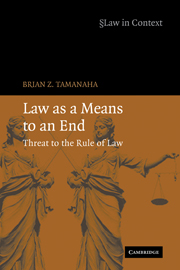12 - Collapse of higher law, deterioration of common good
Published online by Cambridge University Press: 25 July 2009
Summary
In the past two-hundred-plus years, the period traced out in this book, the U.S. legal culture has been deprived of two sets of ideals that provided the foundation for law for more than a millennium. Both of these sets of ideals, in different ways, were central to the rule of law.
The defining characteristic of the first set of ideals was that law consists of fundamental principles that even the sovereign law-maker is bound to obey. This was the classical understanding of the rule of law – the notion that there are legal limits on law itself. The non-instrumental views of law described in the first chapter – divine law, natural principle, reason, customs descended from time immemorial – were the source of these controlling legal principles. Owing to these qualities, it was thought, the law had a built-in integrity, a core of good and right. These non-instrumental views of law grounded, provided content for, and set limits on the law itself. The shift to an instrumental understanding of law had the effect, therefore, of removing a foundational source of grounding, content, and limits on the law, leaving law an empty vessel without built-in restraints.
The defining characteristic of the second set of ideals was that law represents the common good or public welfare. This quality made the law of and for the community, deserving of obedience by citizens.
- Type
- Chapter
- Information
- Law as a Means to an EndThreat to the Rule of Law, pp. 215 - 226Publisher: Cambridge University PressPrint publication year: 2006

